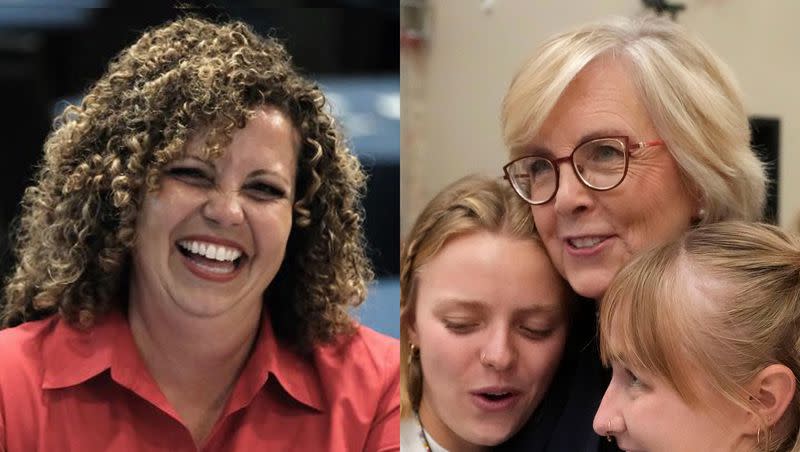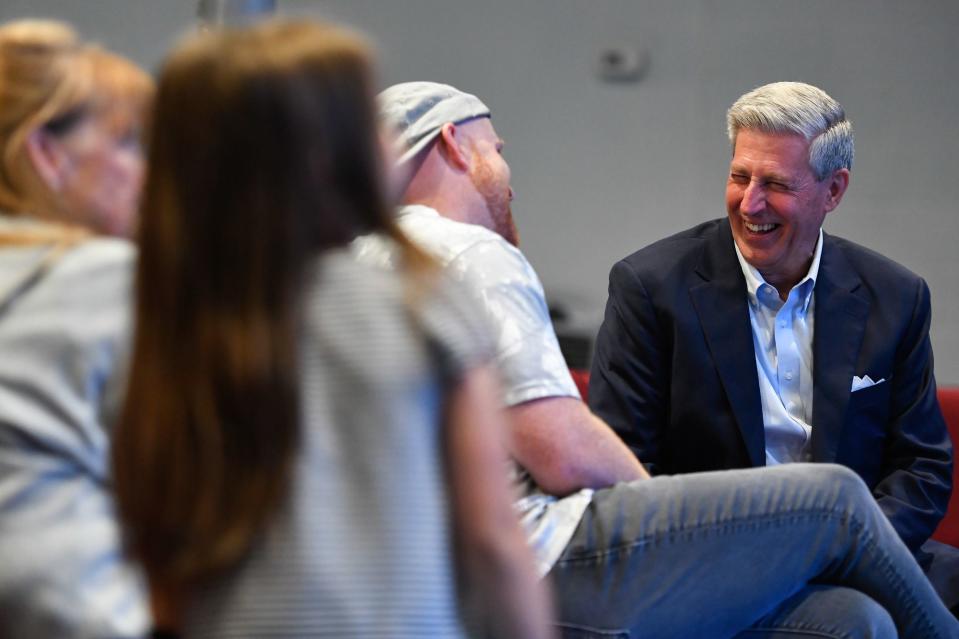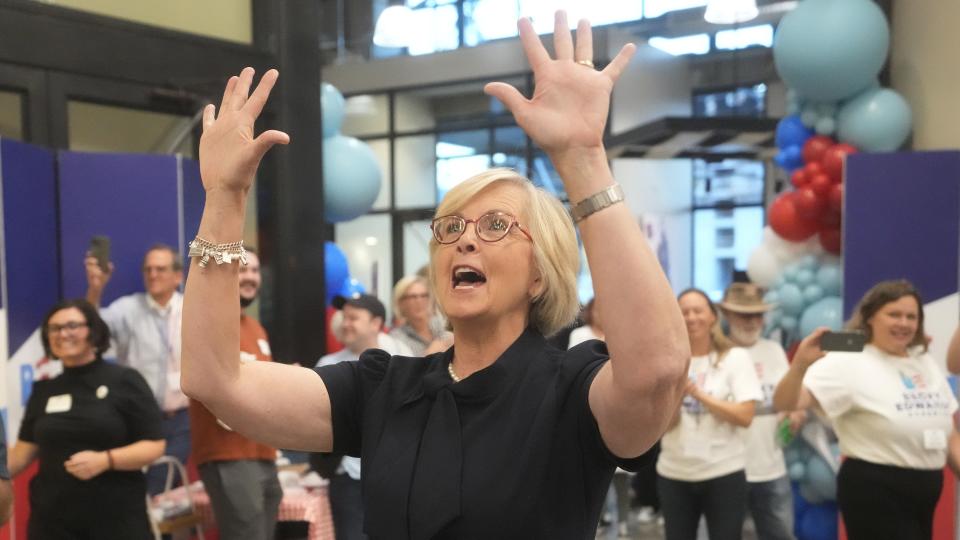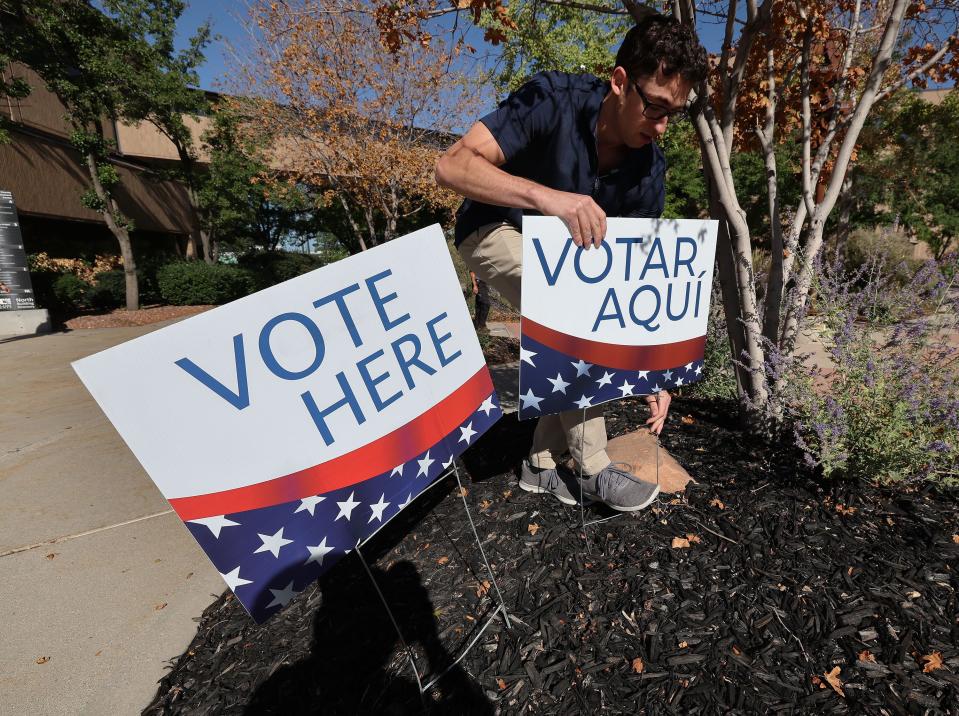Maloy barely leads Edwards late Tuesday as 2nd District race still too close to call

The race to replace Rep. Chris Stewart in Utah’s 2nd Congressional District was too close to call as of late Tuesday night.
Celeste Maloy led her opponents in the special Republican primary election by the end of vote counting Tuesday night because of a strong showing in rural and Southern Utah counties, while Becky Edwards was far ahead in Davis and Salt Lake counties, and Bruce Hough trailed behind.
Vote tallies showed Maloy with a narrow lead over Edwards, 38% to 36%, while Hough had 26% of the vote total as of late Tuesday.
Shortly after 11 p.m., the state said they would not be updating election results until Wednesday.
“All 13 counties in Congressional District 2 are done reporting for tonight. Results will be updated on our website tomorrow at 5pm,” a social media post from Elections Utah said.
The counties that still had the most outstanding votes as of Tuesday night were some of the largest in the district, according to the New York Times, reporting Associated Press results. Salt Lake County had processed 77% of its ballots, Davis County 82% and Washington County 75%. The remaining votes could tip the balance of the race.
Jason Perry, director of the University of Utah’s Hinckley Institute of Politics, said the race was “lining up between urban vs. rural lines, which many expected.”
“While Edwards and Maloy both campaigned throughout the district, they worked hard on their bases and areas of support. Edwards concentrated on urban and suburban areas while Maloy centered on rural Utah. In the returns we have seen so far, rural Utah has shown up and has the capacity to significantly impact this race which is now too close to call,” he said.
Early returns favored Edwards, but later shifted to Maloy
Maloy watched the votes come in surrounded by supporters in a packed ballroom in Cedar City, where she excitedly moved from table to table greeting over a hundred would-be constituents.
“I always knew Salt Lake and Davis Counties would be tough for me,” Maloy told the Deseret News. “I decided early on to have a rural strategy and make sure they felt heard, and seen, and represented, and I think it’s working.”
Edwards was up in the vote count early in the evening after Davis and Salt Lake Counties were some of the first to report. But as more rural counties uploaded their totals the gap between Maloy and Edwards shrunk from 25 points to 10 points and then to nothing as results from Washington County came in.
The preliminary results were met by loud cheers from a few hundred Edwards-watch-party attendees. Edwards was swarmed by hugs from all around as she walked the event space in downtown Salt Lake City, where she was trailed by grandkids covering their ears because of the noise.
“I just hope that we stay on track here,” said Edwards’ communications director, Chelsea Robarge Fife.
Edwards’ husband said he remained “cautiously optimistic.”
The room got quieter, however, as more rural counties reported their results and the gap narrowed, with Edwards thanking her volunteers and telling them to head home at 10 p.m., saying she still felt “optimistic.”
“Thank you for all your efforts to get to this point,” Edwards told supporters. “Thank you for being committed to a shared vision for taking a little bit of Utah to Washington D.C. ... We’re really optimistic and so grateful tonight.”
The mood was also positive at Hough’s watch party in West Valley, where a small group of a few dozen supporters stood by as the results rolled in. Hough was engaged in conversation with four of his grandchildren and some of his children, whom he has made a central component of his campaign. He said he was feeling “confident.”

A sprint to the finish line
For each of the three candidates, the sped-up special election has been a sprint to the finish line.
Each candidate had less than 100 days from the time Stewart announced his resignation to assemble a campaign, raise money, advance through the GOP convention or signature-gathering processes and make an impression on as many 2nd District voters as possible.
And each has approached the abbreviated campaign cycle in their own way.
Edwards branded herself as a “commonsense conservative,” leveraging established volunteers and high name recognition from her prior campaign, where she was known as a more “moderate” Republican who voted for President Joe Biden in 2020.

Maloy leaned on her endorsements from local leaders, including Stewart, as well as her policy experience and southern Utah ties to make her case for increased federalism to rural Utahns, which won her the GOP nominating convention in June.
And Hough tried to clear a lane for himself as the “conservative in the race” with party-line messaging focused on “faith,” “family” and “freedom,” and an ad campaign critical of his opponents’ presidential voting records. Hough has characterized his as an “underdog” race because he can’t count on a network of volunteers like Edwards or the institutional backing of the party like Maloy.
August poll showed large number of undecided voters
According to a Deseret News/Hinckley Institute of Politics poll conducted last month between Aug. 7-14, nearly a majority, 47%, of 2nd District Republicans who planned on voting in the Sept. 5 special primary election were undecided as to which of the three Republican candidates they would vote for with just three weeks remaining in the race. However, Edwards showed an early lead among self-described “moderate” conservatives, with 43% saying they would vote for Edwards if the primary were today, while a majority said they were still undecided.
In an effort to raise her name ID and reach undecided voters, Maloy capitalized on the support she received as the party’s nominee to organize 10 debates with local Republican parties across the district over the first two weeks of August, culminating in a televised debate on KSL. While she challenged both Hough and Edwards to accept the rigorous debate schedule, only Hough accepted, going so far as to schedule his own debate in Salt Lake County to fill what he thought was a gap in Maloy’s original lineup.
Edwards did not attend any of the debates, calling them her “opponent’s campaign events.” Instead, she opted to hold her own voter outreach events in counties across the district, sometimes with several scheduled each day.

With the help of over 1,000 volunteers, the Edwards campaign says it has made 30,000 in-person contacts, 50,000 phone calls and texts, handed out 20,000 flyers, and organized more than 40 events over the last three months in 29 cities across the 13 counties represented in the 2nd District.
Like his opponents, Hough also traveled the state to attend numerous events during his campaign. He also began posting ads on his social media long before any other candidate, with messages ranging from the importance of limiting the size of government to touting his business background. Beginning in August, Hough’s social media became dominated with ads aimed at Edwards for her record of voting for Democratic presidents, including most recently for Biden, and Maloy for her failure to vote in recent elections.
Edwards raised the most money of any candidate, bringing in a total of $678,975 by mid-August, compared to Hough’s $538,700 and Maloy’s $307,308. Of those totals, Edwards loaned her campaign $300,000 and Hough loaned his $334,236. Maloy did not loan her campaign any money.
Edwards’ donations include $5,000 from the Republican Main Street Partnership PAC and $5,000 from The Orthopaedic PAC.
Hough’s campaign funds include maxed-out donations of $6,600 from both Kem Gardner, chairman of Gardner Company, a private commercial real estate business, and his wife, Carolyn, as well as $2,500 from the Natural Products Association PAC.
Maloy’s receipts include a $2,000 donation from the Salt Lake County Republican Party as well as $3,300 from Ally Isom, who challenged Edwards in last year’s Senate primary.
National attention on Utah’s 2nd District
The 2nd District’s special election to fill Stewart’s soon-to-be-vacant seat has drawn national attention for its unique lineup of candidates during a time when a narrow Republican majority in the House has made Speaker Kevin McCarthy’s hold on his conference ever more tenuous.
The race is expected to be the only special election to take place in a red district this year and will be the first since McCarthy and his aligned Congressional Leadership Fund PAC agreed not to get involved in any open primary election for a safe Republican seat.
While McCarthy’s hands may be tied in regards to influencing Utah’s special election, experts say he and other Republican leaders in the House will be watching the race closely, likely hoping that a certain type of candidate will emerge as the winner.
“Leadership will be keenly honed in on this race,” former Utah Rep. Jason Chaffetz told the Deseret News in June. “They want somebody they can work with, and when the votes are close, go get their vote. With such a slim majority this is even more pivotal to how votes will ultimately go.”
But more than anything, McCarthy will want the seat to be filled quickly to bring his majority up from three to four seats, according to Jason Perry, director of the Hinckley Institute of Politics at the University of Utah.
“His interest is, one, that it’s a Republican, and two, that the Republican comes quickly,” Perry told the Deseret News in June, “because the issues before Congress are significant and he wants to keep his majority as large as he can.”
Whoever wins Tuesday’s primary will be likely to go on to win the general election this fall. The 2nd Congressional District is considered a safe Republican seat by the National Republican Congressional Committee, and in 2022, Stewart was reelected by a 25-point margin, 59%-34%. But she or he will be entering Congress during one of the most difficult sessions this term, with a battle looming over the government’s 12 appropriations bills and a potential shutdown if negotiations between the Senate and the House — and McCarthy and his most conservative colleagues — fail to produce a deal.
The winner of Tuesday’s primary will advance to the general election on Nov. 21, where they will face off against the Democratic nominee, state Sen. Kathleen Riebe, as well as nominees from Utah’s other registered parties.

